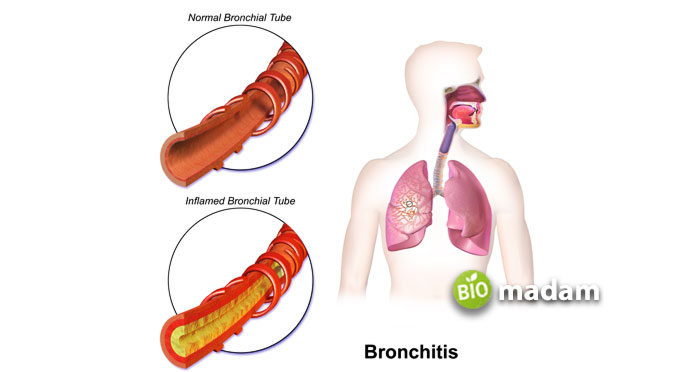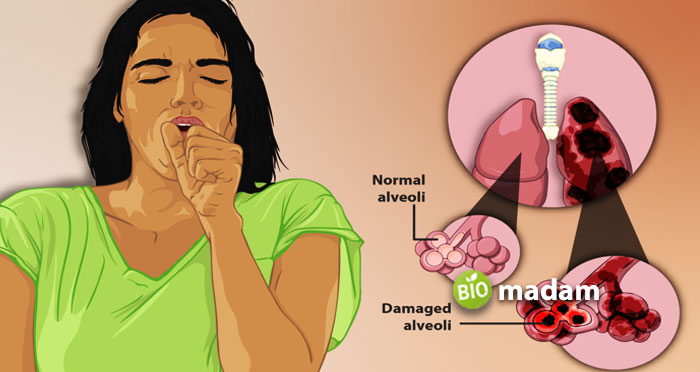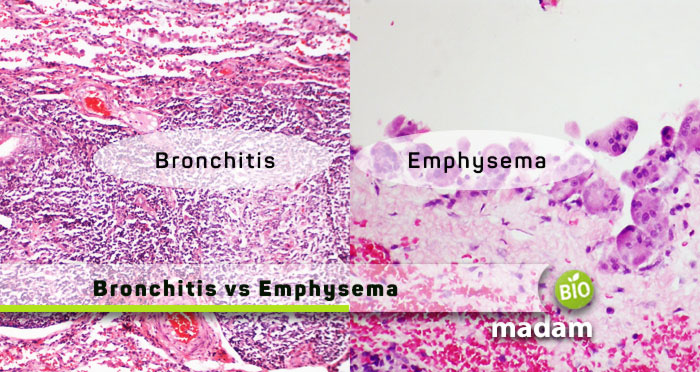Chronic bronchitis and emphysema are among the most common respiratory diseases and disorders besides asthma and COPD. They lead to inflammation and airway obstruction, causing difficulty in breathing. Despite affecting the respiratory system, they differ in their mechanism and may exhibit different types of breathing patterns. The most prominent difference between chronic bronchitis and emphysema is the affected site. Emphysema affects the air sacs, while chronic bronchitis destroys cilia in the lung airway.
Keep reading to learn more about chronic bronchitis and emphysema.
Comparison Table
| Factors | Chronic Bronchitis | Emphysema |
| Definition | Damages cilia | Affects alveoli |
| Risk Factors | Weak immunity, irritants, polluted air, females, etc. | Pollution, genetic factors, males, asthma, allergies, etc. |
| Symptoms | Mucus | Shortness of breath |
| Prognosis | inflammation of the bronchi | Slow alveolar destruction |
| Diagnosis | Spirometry, oximeter, NS test, sputum tests | X-rays, CT scans, blood tests, pulmonary function tests, etc. |
| Treatment | Bronchodilators, anti-asthma drugs, and corticosteroids | Bronchodilators, cholinolytics, body posture, and oxygen |
What is Chronic Bronchitis?
A persistent infection and inflammation of the bronchi is chronic bronchitis. A productive cough lasting longer than three months and occurs more than twice in two years is a sign of chronic bronchitis. When this happens, bronchi and the air passages in the lungs become irritated and inflamed resulting in persistent cough for at least three months. The mucus accumulates because of the irritation in the tubes. Hence, the lungs struggle to transfer oxygen and carbon dioxide out of the body because of this mucus and the swollen tubes. It’s a chronic condition that either continually returns or never entirely heals.

Causes of Chronic Bronchitis
The cilia, the hair-like structures that assist in keeping the air passageways free of pathogens, antigens, and other irritants, can also be harmed by inflammation. Bacterial and viral infections frequently thrive in the airways when the cilia are dysfunctional.
Most medical professionals concur that smoking cigarettes is the primary cause of persistent bronchitis. Lungs are the major organs getting affected by continuous cigarette smoking. Besides, the surroundings at work and air pollution may contribute to bronchitis. Some risk factors that increase the likelihood of it include:
- Smoking: The first and foremost risk factor is inhaling cigarette smoke directly or indirectly through another person who smokes (passive smoking). It may often lead to asthma and bronchitis.
- Lung Diseases: Bronchitis occurs along with other lung diseases like sinusitis, asthma, tuberculosis, etc.
- Inhaled Irritants: Smog, industrial pollutants, and hazardous chemicals are a few inhalational irritants that can lead to bronchitis. Repeated exposure to airborne contaminants such as ammonia and sulfur dioxide increases the risk of chronic bronchitis.
- Age and Gender: Females have twice the risk of developing chronic bronchitis as males. Individuals between the ages of 44 and 65 make up most of the disease’s patient population.
Symptoms of Chronic Bronchitis
The primary chronic bronchitis symptom is a cough lasting more than two weeks. Coughing with bronchitis typically causes the production of mucus, but a dry cough may develop. A person may also notice a whistling or rattling sound (wheezing) when exhaling. Dry air and low humidity in winter can worsen your condition.
Some Other Symptoms Include:
- Disability
- Chronic and severe respiratory diseases
- Limiting and blocking of airflow (bronchi)
- Troubled breathing
- Bluish nail beds, lips, and skin from lack of oxygen
- Swelling of the feet
- The failure of the heart
Chronic bronchitis often presents symptoms easily confused with other lung diseases or medical issues.
Diagnosis
There is currently no definitive test for bronchitis. A person undergoes testing for a variety of other infections and diseases to find the main culprit. Below are some examples of diagnostic procedures that a person may experience. A chest X-ray, spirometry (pulmonary function test), arterial blood gas test, CT scan, pulse oximetry, nasal swab test, and sputum tests are standard diagnostic procedures.
Treatment
Quitting smoking, pulmonary rehab, oxygen therapy, and medications (bronchodilators, antibiotics) are common treatment regimens for chronic bronchitis. Your doctor may prescribe antibiotics for bacterial bronchitis. Severe cases may require a lung transplant.
What is Emphysema?
Emphysema is a disease, also called a condition, that affects the air sacs in your lungs. Typically, these sacs have elasticity or stretchiness to them. Each air sac expands somewhat, becoming more like a balloon as you continue to breathe in. When you exhale, the air sacs in your lungs deflate, allowing the air to exit the body.
Damage to the alveolar walls of the right or left lung leads to emphysema. If alveoli are damaged, less oxygen can enter your bloodstream. Due to a possible obstruction, air may become trapped within the lungs. Too much air in the lungs gives a barrel chest or a broader appearance in the chest area.
Emphysema is a subtype of COPD (chronic obstructive pulmonary disease). COPD is a collection of progressive lung disorders that make breathing difficult. Such patients generally have both emphysema and chronic bronchitis, although the severity of each condition may vary.

Causes of Emphysema
Smoking is the primary cause of emphysema. However, it can have other origins as well. The irritant and carcinogenic chemicals in cigarette smoke can also cause lung tissue damage. Smoking causes irritation and cilia damage. Inflammation of the airways increases mucus production, and a lack of ability to cough up that mucus are all symptoms of irritation and injury to the cilia that line the airways. The breathlessness may be a result of these shifts. They consist of the following:
- Marijuana
- Use of electronic cigarettes and other inhalation methods
- Cigar tobacco
- Congestion
- Prolonged contact with substances that irritate the lungs
- Occupational exposure to pollutants found indoors and outdoors, e.g., dust and the pungent odor of chemicals
Symptoms of Emphysema
Emphysema symptoms often don’t manifest until at least half of a person’s lung tissue has been gone. Before that time, you may notice you’re fatigued and short of breath (fatigue).
- Coughs or wheezing symptoms
- A cough brings up a significant amount of mucus
- Symptoms of shortness of breath, mainly when doing some strenuous activity
- A squeaky or whistling sound occurs as you breathe in
- A constriction or heaviness in the chest
- Stress and physical symptoms of anxiety
- Difficulty in sleep
- Common cold and the flu
Diagnosis
The symptoms such as whistling sound when breathing and a broader chest play a major role in understanding the disease. Furthermore, tests, such as those assessing lung function, a chest X-ray or CT scan, and blood tests, pulmonary function tests like chronic bronchitis, also help identify the disease.
Treatment
Lifestyle adjustments, such as not smoking and avoiding pollution, are the main course of action for emphysema. Antibiotics, anti-inflammatory drugs, bronchodilators, inhaled and oral corticosteroids, and oxygen therapy are also often used to treat these respiratory conditions.
Similarities between Chronic Bronchitis and Emphysema
- Chronic bronchitis and emphysema are types of COPD.
- Smoking is a major trigger for both diseases.
- These conditions are not entirely curable, and the signs and symptoms can only be managed through bronchodilators, steroids, and cough medication.
Difference between Chronic Bronchitis and Emphysema
Definition
Chronic Bronchitis
Chronic bronchitis is a form of bronchitis that affects the lungs and damages the cilia in your airways.
Emphysema
Emphysema, on the other hand, is a degenerative lung disease that destroys the air sacs called alveoli in the lungs.
Risk Factors
Chronic Bronchitis
A weak immunity, irritants, and polluted air are few of many possible risk factors of chronic bronchitis.
Emphysema
Meanwhile, air pollution, hereditary factors, male gender, allergies, asthma, age, and alpha-1-antitrypsin deficiency may lead to emphysema.
Prominent Symptom
Chronic Bronchitis
Mucus production is one of the most noticeable signs of chronic bronchitis, a cough that brings forth thick, colored (yellow, green, or yellow-gray) mucus from the lungs.
Emphysema
Whereas the most prominent sign of emphysema is chronic shortness of breath and whistling sound when breathing.
Prognosis
Chronic Bronchitis
Chronic bronchitis causes instant inflammation of the bronchi.
Emphysema
Contrarily, emphysema prognosis is slow and steady and leads to the destruction of the alveoli.
Diagnosis
Chronic Bronchitis
Persistent cough with mucus production for at least three months each year for two years is the diagnostic criteria for chronic bronchitis. Diagnostic tests like a chest X-ray, spirometry (pulmonary function test), arterial blood gas test, CT scan, pulse oximetry, nasal swab test, and sputum tests also help identify the condition.
Emphysema
At the same time, emphysema diagnosis is problematic because it gradually damages the alveoli. However, chest X-ray or CT scan, and blood tests, pulmonary function tests may help.
Treatment
Chronic Bronchitis
Chronic bronchitis treatments include bronchodilators, cough medications, anti-asthma therapies, and corticosteroids.
Emphysema
Alternatively, bronchodilators, cholinolytics, body posture, and oxygen can ease breathing. Only lung transplantation cures emphysema.
The Bottom Line
Chronic bronchitis and emphysema are COPD diseases that affect the functioning of the lungs and are not entirely curable. The changes in anatomy leading to physiological disturbances cause discomfort to the patient and may become a life-long problem. The main difference between the two is that bronchitis causes inflammation, while emphysema destroys alveoli. These conditions do not fully recover and can only be managed. Though, the only cure for emphysema is a lung transplant.
FAQs
Does chronic bronchitis always turn into emphysema?
Chronic bronchitis and emphysema are two distinct diseases arising from different reasons. Chronic bronchitis is the inflammation of the lungs while the lung tissue is damaged in emphysema. None of the conditions turn into another.
Can you have emphysema without chronic bronchitis?
Yes, emphysema may occur without chronic bronchitis. However, both conditions are types of COPD (Chronic obstructive pulmonary disease) and may occur simultaneously.
What is the life expectancy of someone with emphysema?
The life expectancy of people with emphysema depends on their lifestyle and treatment. People with emphysema can live for five years or more. However, smoking may increase the severity of the disease and reduce the lifespan.
What is the most common first symptom of emphysema?
The first marker of emphysema is shortness of breath, as the disease damages the lung tissues. Thus, it makes it difficult for Emphysema patients to breathe properly.
Can emphysema be mistaken for bronchitis?
The initial symptoms, like shortness of breath and wheezing, may seem similar in both conditions, but diagnostic tests help diagnose the exact condition.
What is the most common complication of chronic bronchitis?
The most common complications of chronic bronchitis include pneumonia, dyspnea, respiratory failure, and failure of the right side of the heart.

Anna has completed her degree in Pharmacy from the University of Hawaii. She is serving as a research assistant in a pharmaceutical company. She had a great interest in writing blogs, traveling to different parts of the US, and trying delicious recipes in her spare time.

